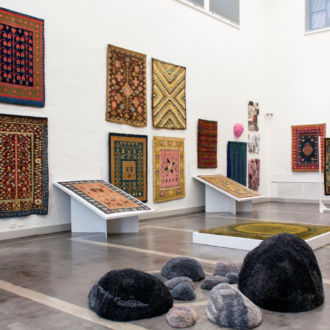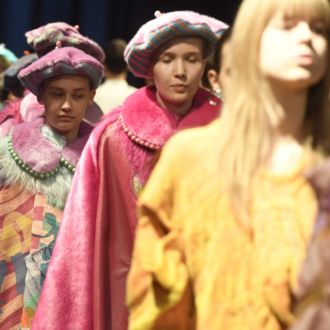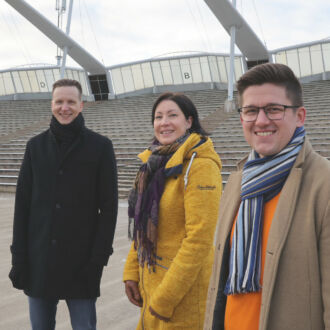The Design Museum in Helsinki commemorates the 140th anniversary of the renowned Finnish glassware brand and its legacy with Iittala Kaleidoscope: From Nature to Culture. The exhibition offers a chance to check out the company’s creative universe and its position in the design world.
“In the early years of modernism, pioneers of Finnish design such as Aino and Alvar Aalto and Kaj Franck set the foundation for Iittala’s design philosophy: to push boundaries and give people beauty and function,” said Carolina Bade, business director at Iittala, at a press event in spring 2021.
The show at the Design Museum continues until September 19, 2021. For Finnish design fans who are reading this after the fact or who are not able to travel to Helsinki, there are links to online material in the box at the end of this article.
Curatorial storytelling

In 1932, Aino Aalto (1894–1949) designed a glass that won the gold medal at the 1936 Milan Triennial. With step-like layers reminiscent of water ripples, this quintessential Finnish design item is still in production and bears her name. Photo: Iittala
The title of the exhibition, Iittala Kaleidoscope: From Nature to Culture, refers to the dialogue between Finnish ecosystems and their surrounding social and cultural context. The Design Museum displays glassware objects alongside paintings, raw chunks of glass, original artist sketches and other items that help to tell the Iittala story.
The comprehensive exhibition draws on the museum’s extensive collection of over 10,000 Iittala products. Curators Florencia Colombo and Ville Kokkonen chart the history of Iittala since its debut in 1881, guiding viewers through Iittala’s epochs: its origins in the 19th century; its self-proclaimed “crystal age” in the 1920s and ’30s; its mid-century Nordic functionalism and modernism; and its contemporary creativity.
As a brand, Iittala has come to embody Finnishness, much like Marimekko textiles, Fazer chocolate or the Moomin characters by author and artist Tove Jansson. Minimalism, functionality and proximity to nature give Iittala its legacy within Nordic design.
Classic pieces are on view throughout the exhibition, including works by pioneering 20th-century Finnish glass designers such as Timo Sarpaneva, Kaj Franck, Aino Aalto and Oiva Toikka. Interspersed with these objects are glass colour samples, original product-design sketches and wooden moulds. These behind-the-scenes elements provide a glimpse into the creative and logistical processes, almost as if you were stepping into a designer’s atelier.
A fourth state of matter
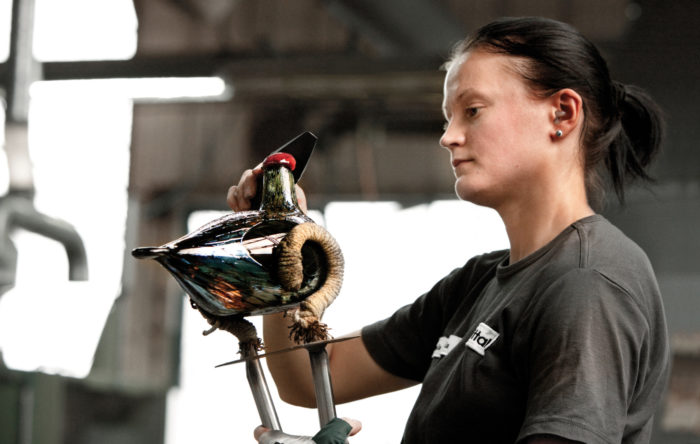
At an Iittala workshop, a glassblower puts the finishing touches on a bird that fans will recognise as one of more than 400 designed by Oiva Toikka (1931–2019). Photo: Timo Junttila/Iittala/Fiskars
Art from other genres provides additional context about the Finnish cultural scene and its relationship to the natural world: an 1899–1900 copy of the score to Finlandia by composer Jean Sibelius, for example, and the 1973 Lennart Segerstråle painting The Destruction of the Environment.
The curators say in the exhibition literature that “glassblowing is a form of embodied know-how that cannot be learned by observation or instruction alone.” The artist must have technical mastery over the glass, but must also have a feeling for the medium.
Glass’s fluidity and unique qualities mean that it is sometimes considered a fourth state of matter, and it is challenging to manipulate. Highly controlled movements and a knowledge of the ways that glass interacts with different materials at different temperatures are essential skills. Many artists have a distinguishable style, which may be visible in the thickness of the glass or even the amount of glass in the corner of an item.
While preparing the exhibition, the curators visited the Iittala Glass Factory multiple times. “It is quite sublime to visit the glassblowers in action,” Colombo said at the press event, adding that many of the designers they met shared “personal stories of their relationships with Iittala.” Once you start recognising Iittala’s signature pieces, you may notice them in many Finnish homes – they’re familiar mainstays and are often passed from generation to generation.
A house of glass
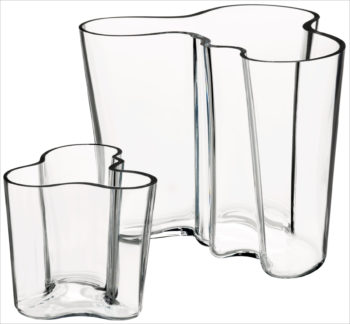
To make an Aalto vase, one of the signature products of Iittala and of Finnish design, you need half a dozen expert glassblowers and a ten-hour, 12-phase work process. The vase was designed by Alvar Aalto (1898–1976). Photo: Timo Junttila/Iittala/Fiskars
One of the Design Museum displays features other iconic Finnish household items, including orange-handled 1967 Fiskars scissors, a 1956 Marimekko shirt and Hackman’s Savonia cutlery, designed in the 1960s (Hackman and Iittala have been part of the Fiskars Group since the late 2000s). Exhibition visitors see how staple household objects connect to a larger narrative of Finnish cultural history. Iittala forms a part of this picture; Nordic functionalism of the 1930s influenced the company’s subsequent design and production.
Iittala has also been active in training glassblowers, right up to the present day. They launched their most recent course, an industrial glass production programme, in 2021. A collaboration between Iittala Glass Factory and nearby Tavastia Vocational College, the course takes two to three years and aims to introduce the next generation of master glassblowers to the craft.
It’s a highly nuanced profession. Making an Aalto vase, perhaps Iittala’s most famous item, requires a team of six or seven glassblowers, employs a 12-phase work process and lasts ten hours. It takes a glassblower five years of work experience to develop the necessary skills to participate in creating this flagship product.
Finding Iittala in the art worldHomes across Finland and around the globe contain items by Iittala designers, and so do museums all over the world. These include MoMA in New York, the British Museum in London, the Musée des Arts Décoratifs in Paris, Gallery A4 in Tokyo, the Museum of Contemporary Art in Chicago and MOCA in Los Angeles. Iittala Kaleidoscope: From Nature to Culture at Helsinki’s Design Museum is open for in-person visits until September 19, 2021, with periodic guided online tours via their Facebook account. Maybe you’re reading this after the fact, or maybe you couldn’t visit because of coronavirus-related restrictions. In that case, check out the wealth of material the Design Museum has online, including photos, the curators’ short introduction to the exhibition, and a longer curator-narrated video tour. For hardcore fans of Finnish glass, Iittala has online tours of its factory and its own collection of classic Iittala items. |
By Emma De Carvalho, August 2021


